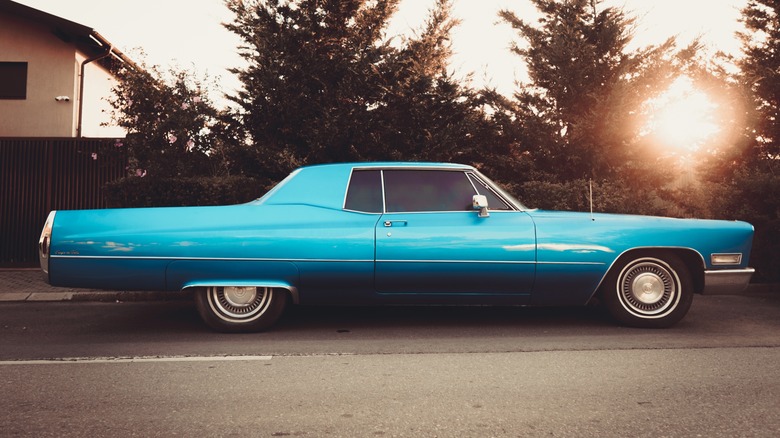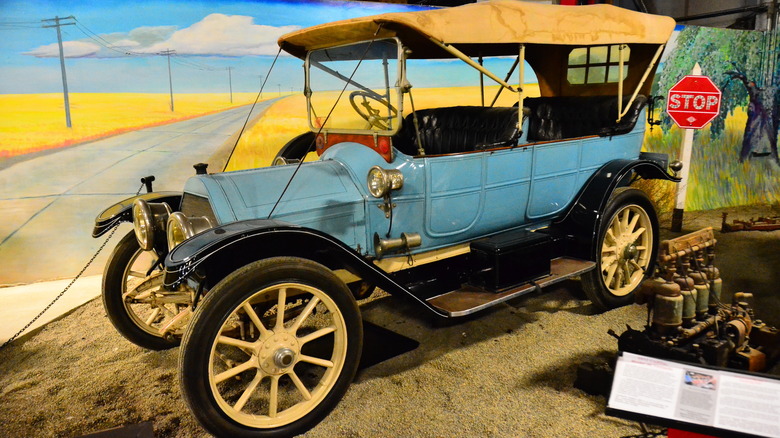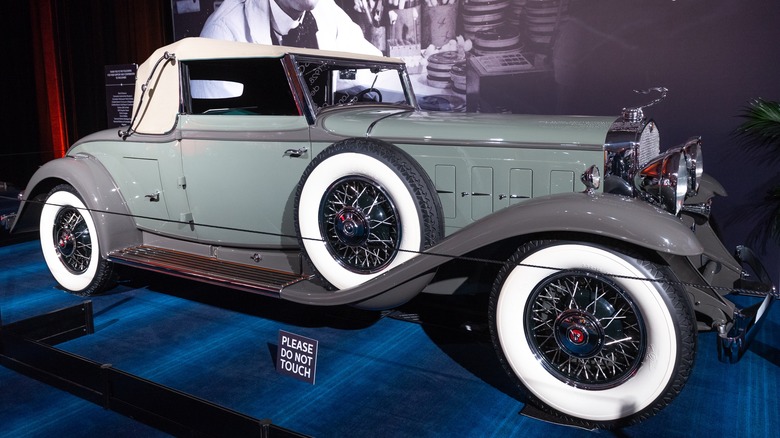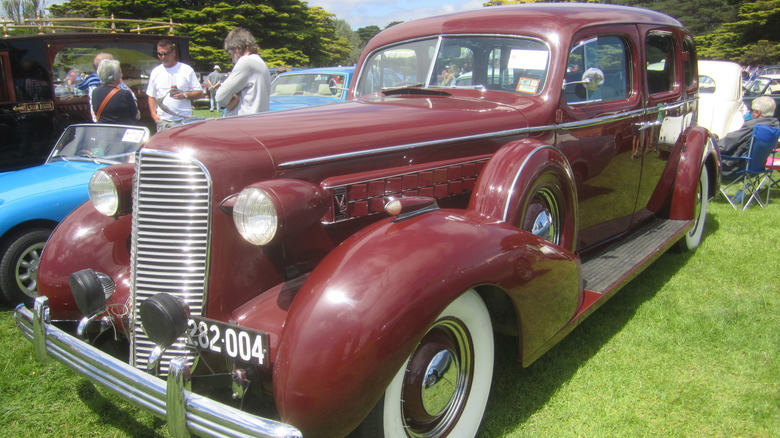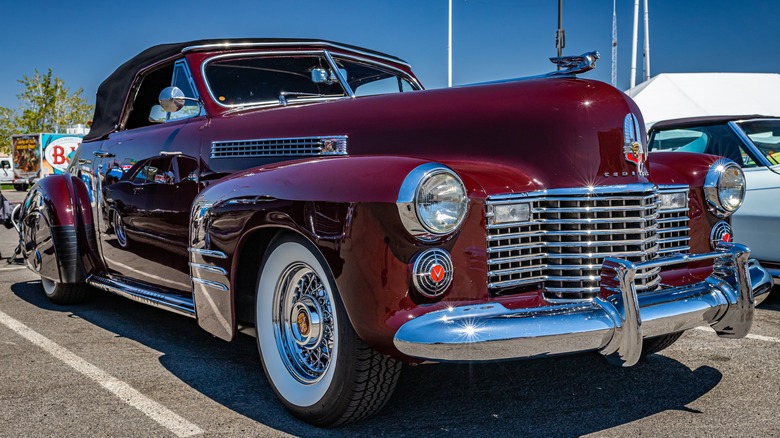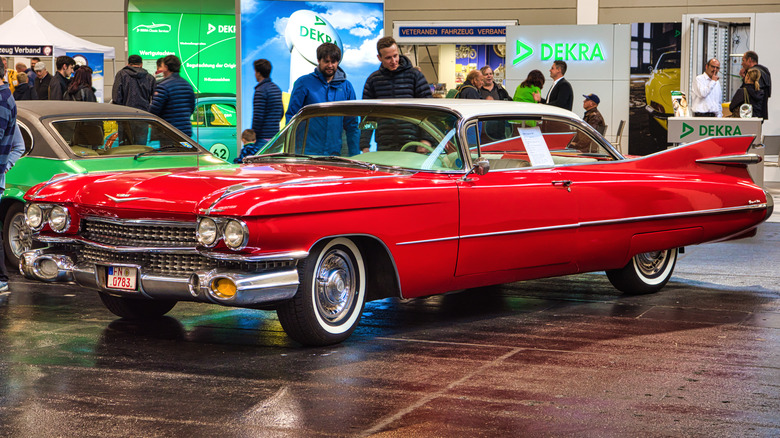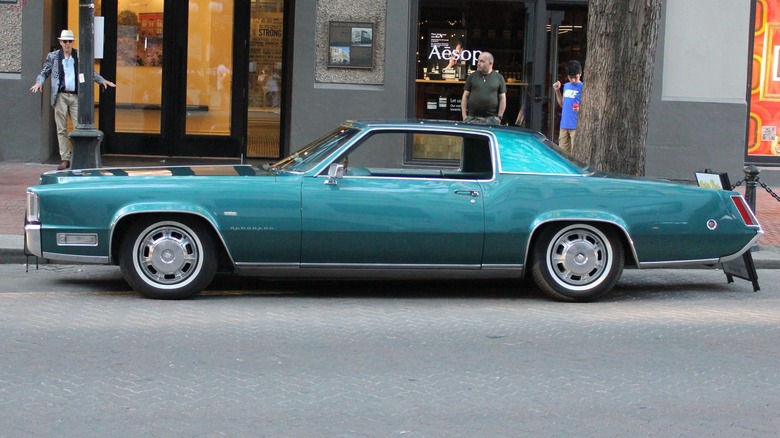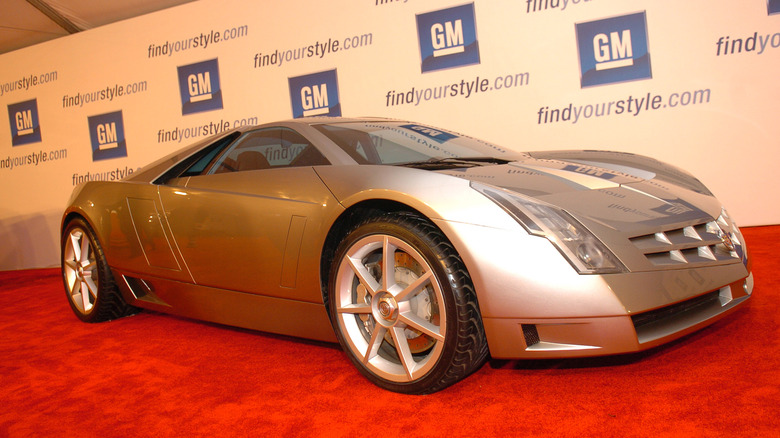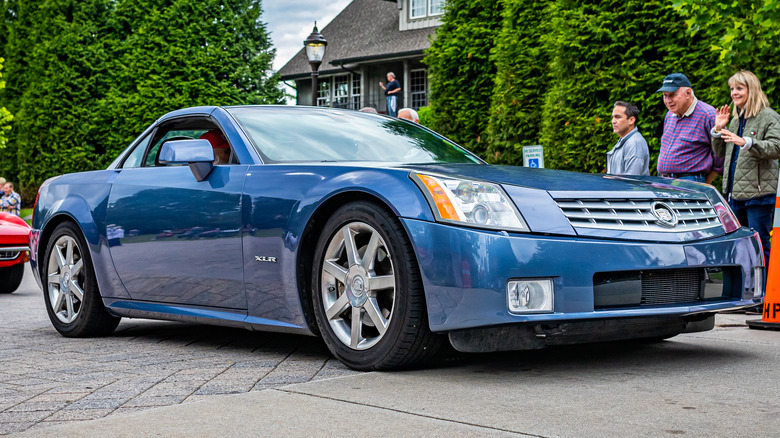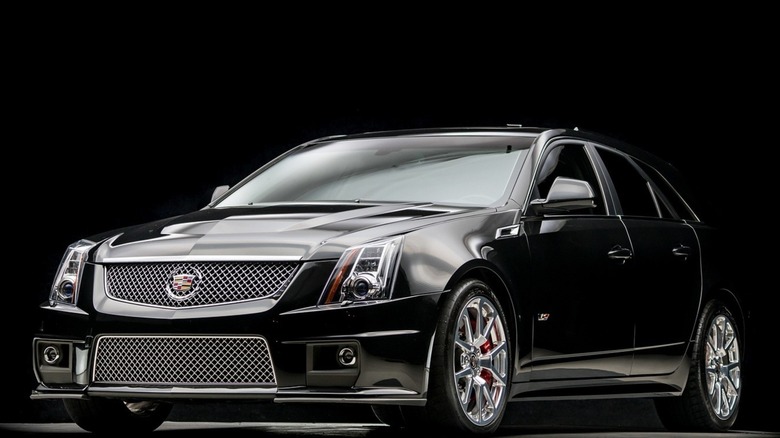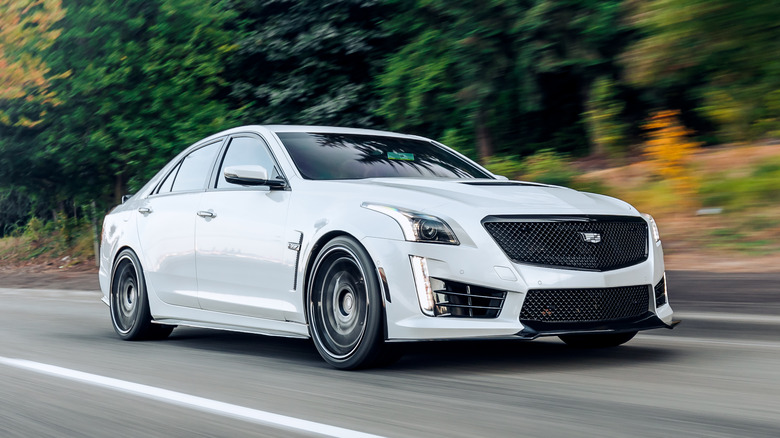10 Of The Best Looking Cadillac Models Ever Designed
By 1902, American machinist, engineer, and inventor Henry Leland had spent eight years honing his bicycle and marine engine development skills at his Detroit factory. Driven by a desire to push boundaries, he convinced the board of directors of the Henry Ford Company (Ford himself had left the company by then) that he could establish a groundbreaking new company. Leland's vision was to combine the auto engines he developed for Random Olds with a Ford auto body to create an entirely new vehicle.
Named in honor of Detroit founder Antoine de la Mothe Cadillac, the new company made a grand entrance at the 1903 New York Auto Show, securing over 2500 orders for its meticulously crafted vehicle at $850 each. Leland wasted no time constructing a new factory in Detroit. The company's innovation was recognized in 1908 when it was awarded the prestigious Dewar trophy. A year later, Leland decided to sell Cadillac to General Motors. The Cadillac automotive company became the Cadillac Motor Car Division.
Among the first automakers to offer a fully enclosed cabin, electric ignition, and interior lighting, the fledgling GM division became known for being a cut above some simpler and more affordable designs. Throughout the automobile's earliest development, Cadillac earned an enduring reputation for power and prestige. In the century and a quarter since Cadillac introduced some of the most classic cars of all time, join us as we examine some of the best-looking models the Detroit automaker ever put on the streets.
Model 30
Today, the charm of a hand-built car signals a level of bespoke excess enjoyed by Ferrari, McLaren, and Bugatti customers. However, once upon a time, the need for standardized machining processes presented problems for automakers in the burgeoning industry. Henry Leland was one of the earliest innovators to tackle this issue. Six years after Cadillac's founding, Leland earned the coveted DeWar trophy for proving that his Model K could be disassembled and reassembled using 89 critical replacement parts. He built on this success with the Model 30.
During an era when automobiles were still referred to as horseless carriages, the Model 30's design was far from outdated. Today, a Model 30 is a nostalgic reminder of a time of rapid change and progress. With its boxy, square shape and wooden-spoked wheels, the Model 30 resembles a horse-drawn carriage. While it may not be considered conventionally beautiful, its quaint charm is undeniably classic. In its time, the Model 30 was a pinnacle of modernity, mainly due to its revolutionary electric starter.
One tragic incident involving a friend of Henry Leland's and a crank-started car led to an innovation in the Model 30. The standard ignition process of the time, which required manual cranking, was a considerable drawback for consumers. In 1912, Leland introduced an electric start to the Model 30, ensuring such accidents would never happen again. The image of cutting-edge technology also included electric lights and a 256 cubic-inch four-cylinder engine with 40 horsepower. Not bad for a horseless carriage.
[Featured image by Dariusz Jemielniak via Wikimedia Commons | Cropped and scaled | CC BY-SA 4.0]
1930 Cadillac V16
By 1930, Cadillac had advanced beyond introducing electrical starters and figuring out interchangeable parts into something truly grand. The 1930 Cadillac V16 is a marvel of engineering and a work of art cruising the streets. The enormous Cadillac arrived immediately on the heels of the Roaring Twenties, an era of unprecedented prosperity in the United States, and its design represents the era. Famed auto designer Harley Earl was the mind behind the V16. At his behest, Cadillac's internal coach builder — a term that hints at the horse-drawn carriage days not long gone — Fleetwood created the flowing lines and ornate details behind the body.
Despite being the first car builder to mass-produce a functional and practical V8 engine, Cadillac wanted to go bigger. And what better way to do that than link a pair of V8s to the same crankshaft? The V16 necessitated a car length increase of an entire foot and a curb weight increase of nearly a thousand pounds, but bigger is better, right? At almost 20 feet long and at 6,200 pounds, Cadillac certainly hoped so.
Beneath the hood, the 45-degree, 452 cubic-inch V16 was a powerhouse. It generated a formidable 161 to 175 horsepower, a significant figure for its time. But the real showstopper was its torque, an astonishing 318 pound-feet, which allowed it to move at idle RPM in third gear. With these impressive numbers, the Caddy could reach a top speed of 80 miles per hour, solidifying its status as an authentic performance Cadillac for its era.
Series 80
The V16 may have been the high-water mark in terms of the number of cylinders in a Cadillac, but six years later, consumers still had the option of ordering Cadillacs with sixteen cylinders. However, they could also choose eight and twelve-cylinder models (it was the Great Depression, something had to give). The Series 36-80 was 131 inches long — nearly half the size of the V16 — and included a 368 cubic inch iron-blocked V12 with overhead valves making 150 horsepower.
The Series 80, an embodiment of the 1930s, used the steel Turret Top body. This one-piece steel roof had been around since 1945 and garnered a sense of safety and stability in consumers' minds. All-steel construction may ring alarm bells in today's safety engineers, but compared to the rickety cloth bimini top of the Model 30 not long before, naming it the Turret Top makes sense.
A louvered, v-shaped grill gives the Caddy a sleek, aerodynamic look, while the bulbous, swept-back front fenders flow in an un-carriage-like way — a testament to the classic auto design of the era. Those who purchased the Series 80 brand new enjoyed several body styles and coaches to choose from, including seven-passenger sedans, coupes, and convertibles. These showcased Cadillac's production prowess and commitment to standardized parts and processes. Today, the classic Series 80, a testament to timeless design, demands an average of nearly six figures on the used market, evidence that its enduring appeal has survived to be appreciated by contemporary car lovers.
[Featured image by Sicnag via Wikimedia Commons | Cropped and scaled | CC BY-SA 2.0]
1941 Series 62
1941 proved a banner year for Cadillac; it built 59,572 cars, the most ever to roll off the production line to date. Designs continued to evolve into the war years, even if Cadillac naming conventions did not. The Series 62 coupe featured a top speed of 100 miles per hour (160.9 km/h) and a 0 to 60 mph time of 14 seconds. Wartime restrictions and advancing technology had given the ax to the big V12s and V16s. Still, the 346 cubic-inch, 90-degree V8 continued the tradition of lopsided performance numbers with 150 horsepower and 283 foot-pounds of torque.
The first generation Series 62 employed hydraulic lifters that helped develop Cadillac's reputation for quiet engines and smooth operation. However, the big luxury item would blow consumers' minds: no longer would they have to laboriously shift their own transmission. Cadillac's Hydra-Matic transmission allowed those who could afford it to rush along America's growing highway systems without the pesky interference of manual shifting. The Hydra-Matic would later serve in M5 and M24 tanks during World War II. But those tanks would not get Cadillac's air-conditioning system — a luxury that added 300 pounds to the curb weight of 4,060 pounds.
Aesthetically, the Series 62 built on previous design cues while introducing new features. Fender-integrated headlights eliminated the buy-eyed features of older cars, while a tiered front grill gave it a toothy look. Cadillac also incorporated several decorative trim pieces throughout the body, including a flashy chrome windshield divider.
1959 Coupe de Ville
Probably the most iconic Cadillac ever built and arguably the most iconic American car to roll off the Detroit assembly lines, the 1959 Coupe de Ville holds a special place in the annals of auto design.
Created during the jet age and on the cusp of the space race, the Coupe de Ville's style looks to the skies. Its most distinctive feature is its twin fins that sprout from the rear end like a fighter jet. The Soviets had put the first satellite into space in October of 1957, and American science and technology were very much focused on replicating and superseding that feat. The zeitgeist pervaded everything from children's toys to pop culture to auto design.
Despite signal lights that mimicked afterburner flames protruding from the fins and brake lights that looked like a rocket's exhaust, the '59 De Ville was not turbine-powered. (Chrysler, however, would introduce a turbine car a few years later.) Instead, a 390 cubic inch V8 made a respectable 325 horsepower — verifiable muscle car numbers, though the gargantuan coupe weighed 4,850 pounds. The 1959 Cadillac Coupe de Ville is that rare car that transcends gearhead fandom and injects itself into the consciousness of society at large. It represents a specific time and place that, love it or hate it, is firmly ensconced in the history of the 20th century.
1967 Fleetwood Eldorado
With a whopping ten generations of production between 1953 and 2002, the Golden One was aptly named. Though they could never know the legendary status it would attain, Cadillac selected the name via a competition meant to honor its Golden Anniversary car show. Cadillac employee Mary-Ann Marini suggested El Dorado — Spanish for "the Golden One" — to her bosses, and a legend was born.
While ten generations of any vehicle are bound to produce some aesthetic duds, the 1967 Fleetwood Eldorado is not one of them. Designed under the direction of Cadillac stylist Bill Mitchell, the eighth generation was based on the E-body shared by the Oldsmobile Toronado. Unlike the Toronado, the Eldorado offered a luxurious interior with options for leather and electric windows controlled from the driver's side door panel. Buyers could expect to pay as much as 34% more than a comparable Toronado with a base MSRP of $6,227 for all this pomp.
It was the late '60s, and the muscle car era was hitting on all cylinders. The long and lean haunches of the Eldorado represented the ethos of the day, though it remained distinctly Cadillac. Hideaway headlights and a squared grille hid a 429 cubic-inch V8, making 380 horsepower and 525 pound-feet of torque.
Cadillac Cien Concept
As we depart the classic era of Cadillac and step into the modern shift to performance, we pause at a little-known concept car called the Cien. In 2002, Cadillac was at a crossroads. While the company had been building beautiful cars for a century, the last few decades had bestowed the brand with a reputation for being fuddy-duddy. Cadillacs had transitioned from the cars of the stars to the barely-driven garage queens of the long-ago retired. A sea change was in the offing, but in the meantime, the Cadillac Cien pointed the way toward modernity.
The Cien debuted at the 2002 Detroit Auto Show as a titillating hint of what Cadillac could be. With an indifferent shrug toward its fellow GM supercar, the C5 Corvette, Cadillac celebrated its centenary with a 750 horsepower 7.5 liter V12 concept known as the Cien. Now, 750 horsepower is positively eyebrow-raising, but in 2002, it was the definition of absurdity. To compare, the top-of-the-line C5 was impressive, with 490 horsepower.
Additionally, all that power was wrapped up in an angular, razor-sharp body that pleases the eye over 20 years later. Unfortunately, there were no plans to produce the Cien. Should Cadillac choose to do so today, the Cien would be the most powerful Caddy ever built, edging out even the modern CT5 Blackwing. While the Cien would not see formal production, it is the evolutionary missing link between the old Cadillac's oversized luxury land yachts and the modern era's performance-oriented BMW fighters.
XLR
The 1980s were a dark time for many American car manufacturers. Gas crises, environmental regulation, and imported competition crushed the large-and-in-charge American-built engines. And Cadillac, for decades one of the largest, watched with horror as its market share shrank year after year. By the end of the '90s, it became clear that not even the Cadillac Northstar's powerful V8 engine was enough to save the beleaguered company. Enter Cadillac's quest for performance and prestige.
Perhaps buoyed by the reception of the Cien, another Cadillac concept made its way into regular production. Based on the 1999 Evoq concept, the XLR was Cadillac's first step away from its old reputation and into the performance luxury world. And perform it did. With distinctive and timeless styling, the slick convertible roadster ultimately boasted a supercharged 4.4-liter V8, making 443 horsepower in its 2006 V model.
Cadillac built the XLR from 2003 to 2009, a relatively short run compared to the Eldorado, but it did the trick. Cadillac buyers began to shift from those seeking to run over a shopping cart without noticing to younger consumers yearning for a combination of power and comfort. While Cadillac had yet to scrap the old engine architecture, the XLR ushered in a new day of forward-thinking styling. The XLR remains a popular yet attainable sports car (for now). The average used price for a base model is around $30,000 on the used market, while the high-performance V-designation demands an average of around $44,000.
CTS Wagon
Cadillac's renaissance took full form in the CTS introduced in 2004. With a commitment to rebuilding the brand in the name of luxury performance, the CTS birthed a fleet of stylish new Caddies as far from the dark ages of the '80s as the '59 Coupe de Ville was from the Model 30.
In 2009, Cadillac turned its new flagship performance sedan into a slick station wagon in the name of complete reinvention. Though the hatchback design drew some raised eyebrows upon its debut, the CTS Sport Wagon has become a much-sought-after model since its discontinuation in 2014. Built on the Sigma III platform, the Wagon competed directly with BMW's 5-series Touring, Audi's A6 Avant, and Mercedes' E-Class T-Model. The modern Caddy wagon can produce up to 322 horsepower and 276 pound-feet of torque with the right options. A 3.0 liter V6 provides power to the rear wheels, and an all-wheel drive option is available.
Cadillac clearly struck a chord with the CTS Wagon; the performance edition of the 2011 model commands an average of $52,000 on the used market, a deprivation of only $10,000 from MSRP in 13 years. Though the Wagon is no longer in production, Cadillac is forging onward with its performance rebirth.
CTS-V
Speaking of the CTS, which debuted in 2004 and ceased production in 2019, the CTS-V rounds out our list of the best-looking Cadillacs ever designed. Deep into Cadillac's shift to performance, the second-generation CTS-V represented the biggest and baddest Caddy available up until the CT5 first hit the market in 2019.
With the first generation CTS-V phasing out of production in 2008 and an unfortunate reputation for exploding differentials, Cadillac beefed up the drivetrain, gave its flagship sedan a facelift for 2009, and built the final iteration in 2019. With performance creeping up each generation, the final CTS came with a supercharged 668 horsepower 6.2 liter V8 that competed with the Corvette Z06. While it did not have the radical aesthetics or the midship engine of the Cadillac C8 Corvette, its angular and menacing looks complement four-door convenience and trunk space to accommodate your whole foursome's golf clubs.
The CT5 Blackwing, which would later pick up where CTS-V left off, somehow looks somewhat less intense than the third-gen CTS-V but remains committed to Cadillac's "new century, new you" approach to breaking performance barriers.
